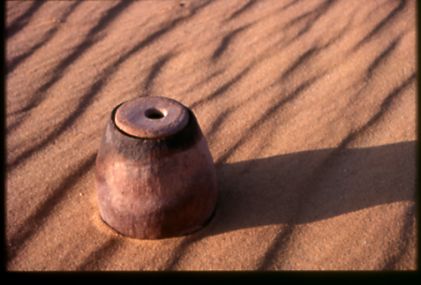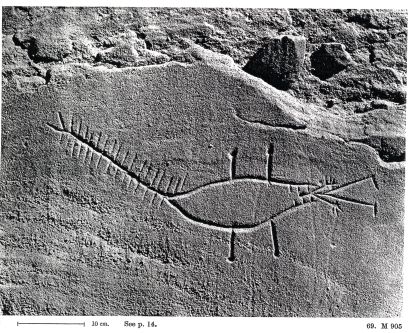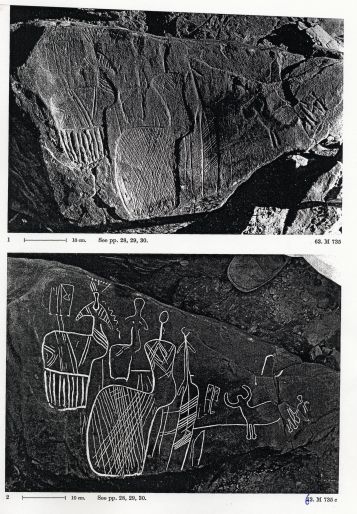Nachtrag vom 6.8.2003
Zum Thema Claytonringe:
Es
könnte sein, dass sich die Menschen in prädynastischer Zeit mit Hilfe der
Claytonringe vor Gefahren, die an Rast- und Übernachtungsplätzen entlang der
Karwanenrouten lauerten, schützen wollten. Denkbar wäre z.B. die Verwendung von
Claytonringen als Skorpionfalle.
Träfe
dies zu, wären aus dem Loch in der lose auf dem Claytonring aufgelegten
Ringscheibe „Duftstoffe“ ausgeströmt, die Skorpione anlocken sollten. Bei
leisester Berührung, dann nämlich, wenn ein gift-stachelbewehrter Angreifer die
Ringscheibe „betreten“ hätte, wäre diese zusammen mit dem Scorpion in die nach
unten sich verbreiternde Hohlform gefallen. Aus diesem Gefängnis hätte sich das
Tier nicht befreien können.
Die
nachfolgende Abbildung gibt das komplette, „freigelegte“ Ensemble eines Claytonring mit Ringscheibe wieder.

Zum Thema Sheikh Muftah-Kultur:
Hinweise
zur Stützung meiner These, ein Teil der Petroglypen am Wasserberg des
Djedefre und in Biar Jaqub stamme von Mitgliedern der Sheik
Muftah-Kultur, finden sich bei
Winkler, H.A.:
Rock-Drawings of Southern Upper Egypt. Bd. 2, London 1939.
So
hat Winkler in PL. IV, 2 die Petroglyphe eines Krokodils, welches einen
Menschen verschlingt, wiedergeben. Das Felsbild wurde am Rande der Hatiya von
Tenida, Dakhla Oase, entdeckt. Weil die Darstellung zusammen mit
rezentem Bildmaterial erscheint, ist nicht ganz sicher, ob es sich um ein
vorgeschichtliches Werk handelt.
Nicht
weit davon entfernt, nördlich des Darb el-Ghabari, entdeckte der schweizer
Felsbildforscher die in Pl. XXXIX und Pl. XLV abgebildete flachreliefierte
Gruppe „schwangerer“ Frauen. Der Duktus der Darstellungen deckt sich weitgehend
mit dem des „Schönsten Paares“ in Biar Jaqub.
Winkler
führt folgendes dazu aus:
S. 17: „An
archaic civilization has been discovered near Dakhla. These people are called
in this report Early Oasis Dwellers.”
S. 28: „In
nearly all cases the women represented are pregnant. They are carefully dressed
in long skirts in most cases covering the feet. These skirts sometimes display
various patterns. It is apparently woven work. The upper part of the garment is
as a rule neglected… As a rule the
pregnant woman is shown in side view, sometimes in front view. In both views
there are pictures displaying a kind of “divided skirt”. These woven skirts are
occasionally ornamented by bunches of short strips. Strings hanging down from
the waist are the next peculiarity sometimes to be observed. Necklaces (?)
occur but once.”
S. 29: “My
opinion that the pregnant figure is a deity is confirmed by the finest picture
of the series (Pl. XXXIX).”
S. 30 f.: “I
suppose that they belong in some way to the cult of these Early Oasis
Dwellers.” (= Sheikh Muftah-Kultur)...There is a certain similarity in
style between the Uwenat people and the Early Oasis Dwellers. But here in
Dakhla the exaggerating style is no longer balanced. The buttocks or in front
view the hips of women are exaggerated out of all proportion.
To summarize. In the desert east
of Dakhla are traces of early settlements in a depression which at that time
was probably an oasis… These people were probably settled people and earned
their livelihood from plant-cultivation. They used grindstones. The art of
weaving was surprisingly developed. Statuettes of a pregnant woman were of high
importance to these cultivators; possibly they were connected with the idea of
a deity of fertility.”
S. 35
f.: “Near Dakhla the Earliest Hunters appear at the side of another people,
hitherto unknown, the Early Oasis Dwelllers. These were plant cultivators…The
puzzle is to understand how the idea of cultivating arose here. Influence from
outside the Oasis? From where? And if there is no foreign influence, the case
is even more enigmatic. I have wondered, if possibly the women of the Earliest
Hunters could have discovered by themselves the art of growing plants near some
artesian well… But this is impossible. They are distinctly different people… As
a whole they represent a much higher degree of civilization than the Earliest
Hunters… the unimportance of cattle in their economics, their plant
cultivation, their interest in the pregnant goddess, and their techniques are
foreign to the Autochthonous Mountain Dwellers… This foreign .. people knew how
to cultivate plants, smoothe stone, weave quite well, and venerated the
pregnant deity.”
Ganz
zweifellos hat diese ausschließlich in Oasen seßhafte Ethnie (Early
Oasis Dwellers bzw. Sheikh Muftah-Kultur) am
Wasserberg des Djedefre und in Biar Jaqub ihre Spuren
hinterlassen. Nur eine eingehende Analyse der von mir entdeckten
Wasserberg-Symbole, der Feldstrukturen und Bewässerungskanäle wird Winklers
Erstaunen
“The puzzle is to understand how
the idea of cultivating arose here. Influence from outside the Oasis? From
where? And if there is no foreign influence, the case is even more enigmatic.”
in
gesicherte Erkenntnis transformieren.
Winkler´s Pl. IV, 2




